Phishing attacks:
Hackers impersonate legitimate entities in fake emails or on fraudulent websites, tricking victims into revealing sensitive personal information or downloading malware.

The dark web is a hidden layer of the internet that cybercriminals use to trade stolen personal information. If your details end up there, you’ll be vulnerable to predatory identity thieves. With a 30-day free LifeLock trial, our Dark Web Monitoring feature patrols the darkest reaches of the web and notifies you if your data is discovered.
Amid rising cyber threats, the dark web has become a notorious haven for cybercriminals. It plays host to hidden marketplaces where hackers and fraudsters trade stolen data. Information exposed in data breaches is often shared or sold anonymously on these dark web forums, attracting identity thieves looking for their next target.
Facebook, 2019
Data stolen from Facebook during a significant data breach exposed the personal information, including phone numbers and email addresses, of over 533 million users from 106 countries. The data later surfaced on a dark web hacking forum.
LinkedIn, 2021
A hacker operating under the alias "God User" scraped LinkedIn and posted data from 700 million users on the dark web. While LinkedIn downplayed the incident, the leaked data left affected users at risk of social engineering attacks.
National Public Data, 2024
The National Public Data breach exposed 2.9 billion records from 270 million individuals — possibly constituting the largest data breach ever recorded. Hackers subsequently sold the stolen data for $3.5 million on a dark web marketplace.
Dark web monitoring tools can alert you if we find that your information is exposed on the dark web, allowing you to take swift action following a data breach to help protect your identity before it’s too late.
Protect against identity theft
It can be almost impossible to tell if your sensitive data has leaked online until you notice fraudulent activity in your name. Monitoring the dark web provides an early warning system for potential threats, helping you take protective steps to protect against identity theft.
Minimize the risk of financial loss
Identity theft resulting from data breaches can lead to unauthorized transactions, drained bank accounts, and fraudulent loans in your name, leaving you to dispute charges and rebuild your credit, all while enduring financial instability and stress — dark web monitoring may help you avoid it.
Get greater peace of mind
Dark web monitoring services foster peace of mind by notifying you of compromised personal data on hidden websites. Knowing that the darkest corners of the internet are being monitored around the clock reassures you that you’re not an easy target and can act quickly if a threat arises.
Worried your information may already have leaked? Run an exposure scan using our free online tool to see how much of your data is listed on the dark web and what level of risk it poses to your identity and finances.
The dark web is a hidden section of the internet that only exists on encrypted networks and is inaccessible through traditional browsers or search engines. While it has legitimate uses, its anonymous nature attracts cybercriminals looking to operate discreetly and makes it a popular online hangout for bad actors trading stolen data or illegal goods and services.
The dark web is a mysterious place for most people, but it’s familiar to identity thieves. They use it to find stolen data, picking out new targets for their fraudulent schemes. If your data is exposed there, you might be at risk. Learn more about the dark web in this episode of Unlocking the Truth.
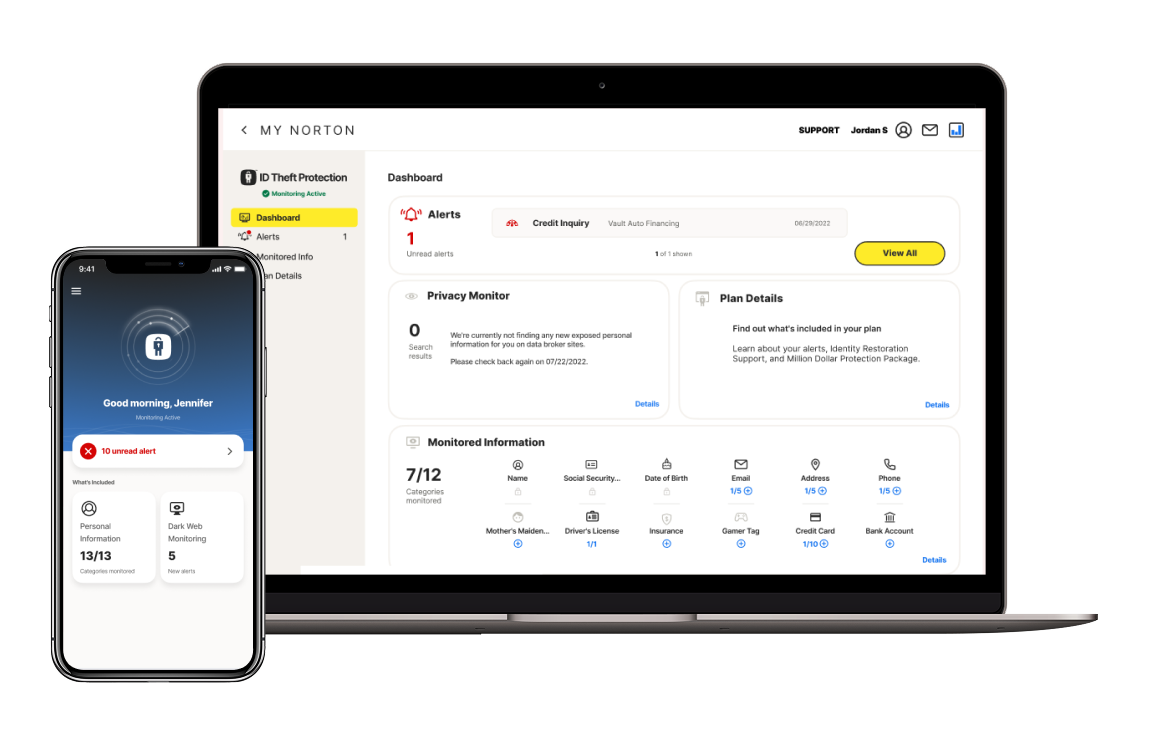

Try LifeLock to access our Dark Web Monitoring feature, which continuously scans the dark web for traces of your personal information. You’ll also benefit from a comprehensive range of identity protection features, including automatic alerts flagging potentially fraudulent use of your Social Security number, name, address, or date of birth. Get peace of mind today.
Dark Web Monitoring is a cutting-edge feature that proactively combs dark web websites for mentions of your personal information, like your Social Security number, email address, or financial details. It sweeps the darkest corners of the web and notifies you if it discovers your details, helping you take action to protect against identity theft risks.
Dark Web Monitoring systematically scans the dark web for any signs of your personal information. Here’s how our Dark Web Monitoring process works, from subscription to notification:
When you activate your LifeLock subscription, our Dark Web Monitoring feature begins scanning the dark web for your email address. You can also provide more information for us to monitor, including phone numbers, Social Security numbers, and bank account details.
Advanced data-matching algorithms are used to comprehensively cross-reference the personal data you provided with information we detect on hidden forums, marketplaces, and databases that may be used by cybercriminals.
If your personal information is detected, you’ll receive a Dark Web Monitoring notification outlining what data was discovered so you can take immediate action to protect yourself.
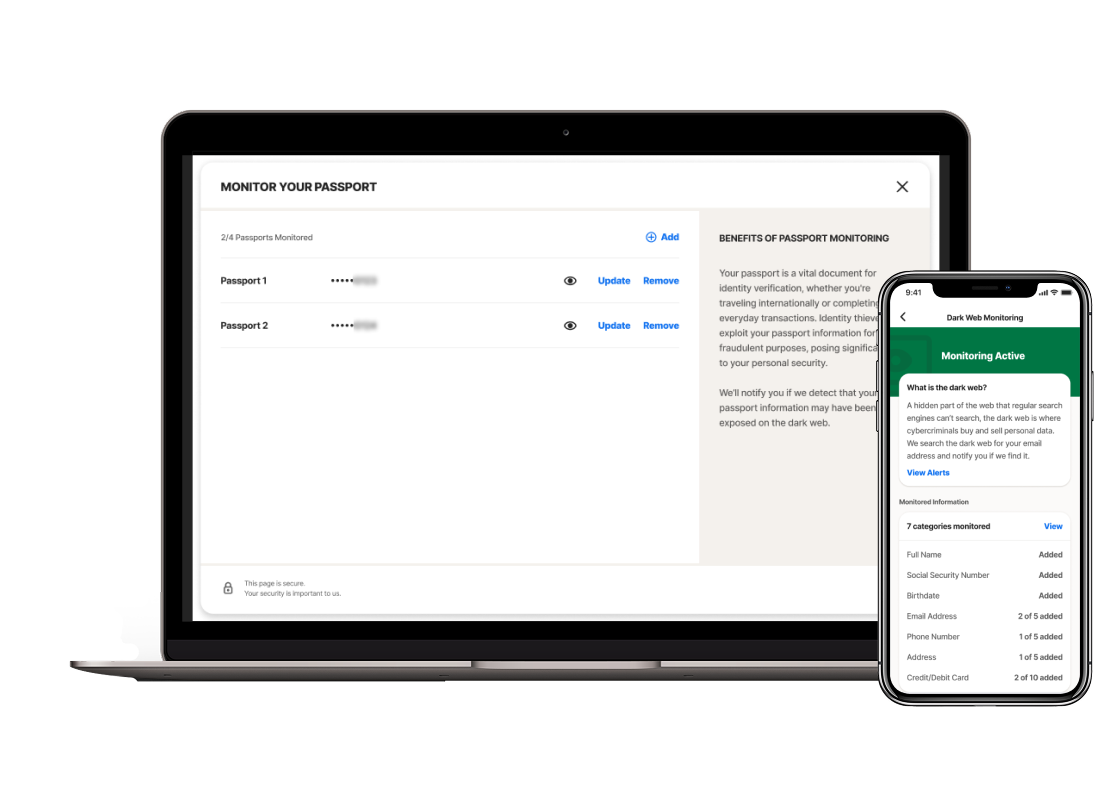

Once you join LifeLock, we start searching the dark web for your email address right away — but that’s just the start. You can also provide a range of additional personal and financial details for us to monitor, including:
Social Security number
Date of birth
Driver's license number
5 physical addresses
5 email addresses
5 phone numbers
10 bank account numbers
10 credit card numbers
10 gamer tags
If your personal information is compromised through a data breach, phishing attack, or hacking incident, it’s usually only a matter of time before it ends up on the dark web. Here’s the typical process that leads to your details being exposed to malicious dark web users:
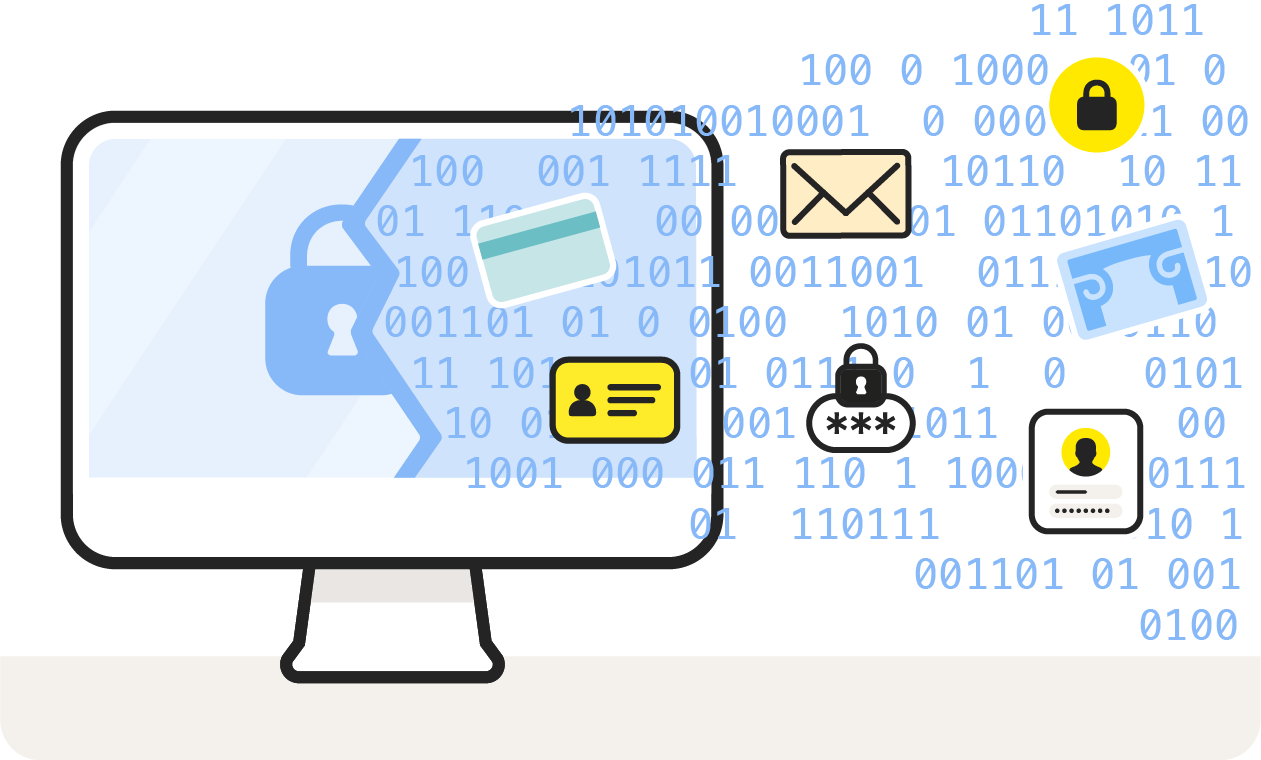
It all starts with a vulnerability — a weakness through which your personal data is leaked or breached via a targeted attack. Hackers attempt to identify and exploit system vulnerabilities using malware, phishing, and other techniques to target devices, networks, or databases.

A data breach occurs when cybercriminals successfully infiltrate a database and steal large volumes of sensitive or personal information. These breaches can target both individuals and diverse organizations including ecommerce businesses, healthcare providers, and financial institutions, exposing valuable data like email addresses, passwords, and payment details.
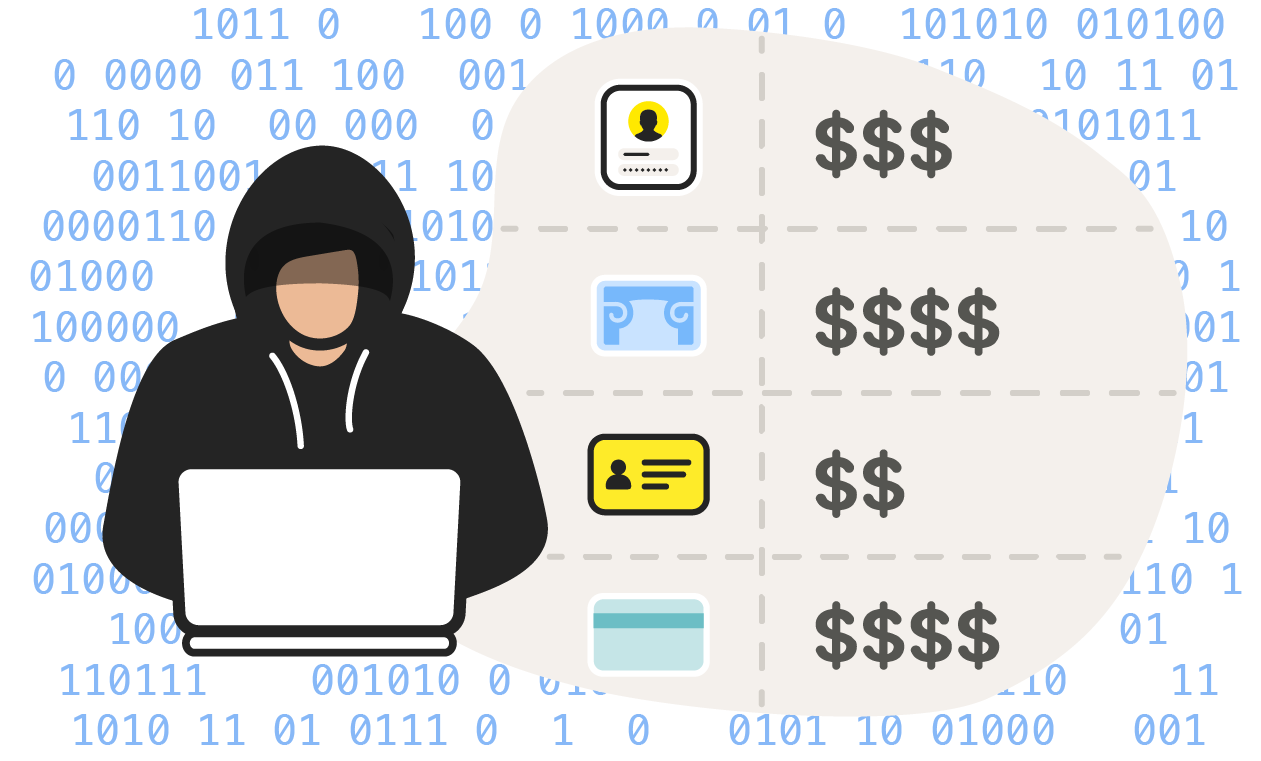
Once they have their hands on personal data, cybercriminals usually attempt to quickly monetize it by anonymously listing it for sale on the dark web. It’s bought by other crooks who then attempt to use information including Social Security numbers, credit card details, and login credentials to commit identity theft or fraud.
All sorts of dangers stem from the anonymity offered by the dark web. Cybercriminals capitalize on this unregulated, hidden network to share hacking techniques, offer illicit services, and trade stolen data, fueling the rise of identity theft and other crimes. These are some of the most common types of threats on the dark web:
Hacking and malware services
Hackers advertise services for hire and share malware tools like spyware and ransomware, enabling even unsophisticated criminals to launch devastating attacks. Recent reports show the number of dark web ransomware groups increased by 56% in the first half of 2024.
Illegal markets
Even though the Silk Road was shut down in 2013, the dark web is still teeming with markets trading in all sorts of illicit goods and services, from stolen Social Security numbers and counterfeit documents to drugs and weapons. A total of $1.7 billion in dark web sales were made in 2023 alone.
Identity theft
Stolen personal information is one of the main illicit “products” for sale on the dark web, and it’s a major driver fuelling identity theft. With the number of data breaches reaching a record high in 2023, the number of potential victims at risk snowballs.
Financial fraud
Certain dark web forums are filled with stolen credit card details, online banking credentials, and cryptocurrency wallet keys. Cybercriminals posted nearly 60 million payment card records on dark web marketplaces in 2022, putting millions of people at risk of financial fraud.
Data breaches occur when cybercriminals exploit vulnerabilities in an organization's security measures, gain unauthorized access to databases, and then extract information from the compromised network. Common methods used by cybercriminals to execute data breaches include:
Phishing attacks
Malware
Exploits
Insider threats

Phishing attacks:
Hackers impersonate legitimate entities in fake emails or on fraudulent websites, tricking victims into revealing sensitive personal information or downloading malware.
.png)
Malware:
Malware, and particularly spyware, is often a key tool in data breaches, designed to infiltrate systems, steal data, disrupt operations, or create backdoors for prolonged access.

Exploits:
Unpatched software, outdated systems, or misconfigured servers create opportunities for hackers to exploit security flaws and gain unauthorized access to networks.
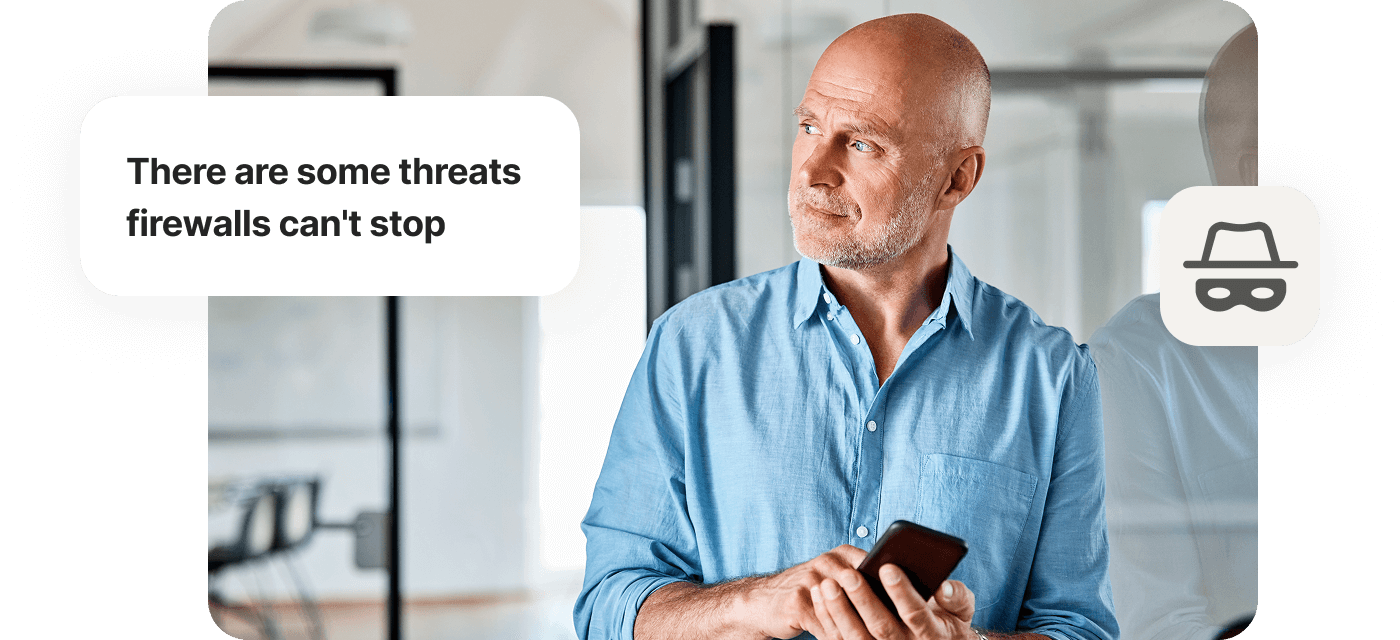
Insider threats:
Disgruntled employees or careless staff may intentionally or accidentally expose sensitive information by leaking it or mishandling data.
If your personal information is found on the dark web, it’s a possible indication that you’ve been impacted by a data breach or hacking attack and are vulnerable to identity theft. Identity thieves can exploit this stolen information to impersonate you, gain access to your financial accounts, take out new lines of credit, or commit criminal acts under your name.
LifeLock's Dark Web Monitoring service is designed to help you swiftly identify and respond to potential threats following a data breach, providing notifications whenever it discovers your personal information on the dark web.
LifeLock takes a comprehensive, proactive approach to safeguarding your identity, offering access to a valuable suite of services including Dark Web Monitoring, Credit Monitoring Coverage, and Identity Alerts. And, if you ever have your identity stolen, a U.S.-based personal restoration specialist will be on hand to help repair the damage.
Here are some of LifeLock’s most powerful features:
Dark Web Monitoring: Continually scours the dark web for traces of your personal information and notifies you of any findings.
Credit Monitoring: Scrutinizes your credit report for key changes or updates, with alerts issued when suspicious activity is detected.
Privacy MonitorTM: Scans public people-search sites for your personal information and helps you opt out, boosting your online privacy control.
Identity & Social Security Number Alerts: Monitors for fraudulent use of your personal information in credit applications and sends automatic alerts.
Identity Restoration Services: A Personal Restoration Specialist assists you in restoring your identity if it’s ever compromised.
When you become a LifeLock member, Dark Web Monitoring is just the start. You’ll benefit from a cutting-edge array of identity theft protection features to help cover all angles.
Early detection
With continuous monitoring of the dark web, and regular credit report and public database checks, we can notify you of suspicious activity, helping you act fast to protect yourself and minimize potential damage.
Comprehensive protection
Our multi-faceted approach to threat detection addresses diverse risks, going well beyond those posed by the dark web, to help you protect all aspects of your identity across platforms where you may be vulnerable.
Reduced exposure
Nobody can prevent identity theft completely, but the information provided by our monitoring tools gives you more power to limit exposure of your personal details and boost your online privacy, helping protect against key risks.
Expert restoration
If the worst happens and you become a victim of identity theft, LifeLock still has your back. Our U.S.-based Personal Restoration Specialists work with you to help restore your identity and resolve any damage.
Join LifeLock today for Dark Web Monitoring that can help you stay one step ahead of threats to your identity that lurk in hidden corners of the internet. Let our comprehensive suite of tools, features, and expert assistance help keep you safe and protected.
Dark web monitoring is a valuable tool that can enhance your protection against identity theft and fraud. It serves as an early warning system, alerting you when your sensitive information is detected on the dark web so you can take vital protective measures.
A dark web monitoring alert is issued when your personal data is discovered on the dark web. That empowers you to swiftly take action to safeguard your information and reduce the risk of identity theft.
LifeLock uses sophisticated monitoring technology and advanced algorithms to scan hidden, unindexed areas of the internet for personal information including email addresses, Social Security numbers, or credit card details.
Given the dynamic nature of the dark web, no service can claim to monitor it in its entirety. However, our Dark Web Monitoring feature extends beyond easily accessible websites and markets, delving into private forums and other deep web domains for effective coverage.
The process of removing your information from the internet is difficult at the best of times, and once your data is circulating on the dark web, it’s practically impossible. Dark Web Monitoring offers the next best thing, alerting you when your information is discovered so you can respond to threats by protecting your accounts or finances.
To learn more about the dark web and how to protect your identity, check out these related articles:
LifeLock is part of Gen – a global company with a family of trusted brands.
Copyright © 2025 Gen Digital Inc. All rights reserved. Gen trademarks or registered trademarks are property of Gen Digital Inc. or its affiliates. Firefox is a trademark of Mozilla Foundation. Android, Google Chrome, Google Play and the Google Play logo are trademarks of Google, LLC. Mac, iPhone, iPad, Apple and the Apple logo are trademarks of Apple Inc., registered in the U.S. and other countries. App Store is a service mark of Apple Inc. Alexa and all related logos are trademarks of Amazon.com, Inc. or its affiliates. Microsoft and the Window logo are trademarks of Microsoft Corporation in the U.S. and other countries. The Android robot is reproduced or modified from work created and shared by Google and used according to terms described in the Creative Commons 3.0 Attribution License. Other names may be trademarks of their respective owners.